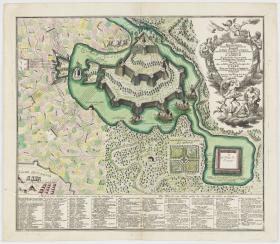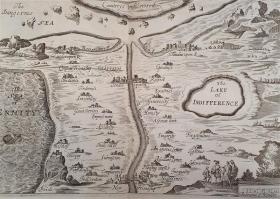All’s fair in love and war
From the 16th century onwards, many mapmakers attempted to draw one of the most mysterious and treacherous terrains — the human heart. Although they don’t depict actual places, these allegorical ‘love maps’ use recognisable features of the physical landscape such as islands, oceans, rivers and mountains. Frequently they depict love as a journey or end destination, with many dangers to avoid along the way. Recently, the Library has acquired a beautifully decorative and complex example of this genre, that instead borrows the style of a war map to turn love in to a battle.
Nicknamed ‘The Attack of Love’, it was produced by the engraver and map publisher, Matthäus Seutter, in Augsburg Germany, c 1730. The map depicts the male heart, kept in a fortress, surrounded by the ‘Passionless, Frozen Sea’. The female attacking forces, under the command of General Cupid, are camped in the bottom left corner. An elaborate key beneath the map, in both French and German, indicates how the siege plays out. The key’s title, ‘method of defending and preserving one's heart against the attacks of love’, seeks to reel the reader in to the action.
Several bastions and canons defend the fortress that include ‘cautiousness’, ‘experience’ and ‘indifference’. Cupid’s forces bombard it from both land and sea, attacking with ‘tenderness’, ‘charms’, ‘pleasant conversation’, ‘little errands’, ‘beauty’, and even ‘un certain je ne sais quois’.
Unable to withstand such relentless attacks, the heart retreats to a number of safehouses outside of the fortress, which form the last line of defence. Among them there is ‘advice from faithful friends’ and ‘deliberation’. Finally, the heart is surrendered at the ‘Palace of Love’, lured there by the song of the surrounding sirens. A note about the Palace explains, ‘easy entry but few shall get out without leaving their freedom behind’.
To complement the subject, the title of the map is framed in a heart-shaped cartouche in the top right corner. It features both Cupid and Venus, the goddess of love, watching the battle below from her chariot pulled by doves.
Mapmakers have created allegorical maps of love for many different reasons. Sometimes they were intended for amusement or to poke fun at social conventions relating to courtship and marriage. Some examples were more provocative, seeking to challenge contemporary attitudes. One of the striking features of Matthäus Seutter’s map is that it casts women in an assertive role, as the pursuer when it comes to matters of the heart.
However, for Seutter to produce such a detailed and finely executed map, it suggests that there was a commercial motivation to do so as well. ‘Love maps’ had become a trend, particularly following the publication of the influential ‘Carte de Tendre’. This foldout map appeared in Madeleine de Scudéry’s novel, Clélie, which was published in instalments between 1654 and 1660. The Library holds an English edition of the map from 1678, showing the land of ‘Tender’ (meaning love), and the possible journeys that can be taken from the town of ‘New Friendship’.
Seutter’s map publishing firm issued a wide variety of maps. This output included war maps and town plans featuring fortifications, which is perhaps where the inspiration for ‘The Attack of Love’ came from. By this period maps were a key means of sharing information about contemporary conflicts, and the topic of fortifications was itself widely published about. Using the style of a siege map would have been highly effective for Seutter because of how recognisable they had become.
This map is a wonderful addition to the Library’s collection, showing how the art of cartography has been used to help us explore that eternal preoccupation of humankind, love.
Alice Tonkinson is assistant curator of the Maps of the Pacific exhibition.

